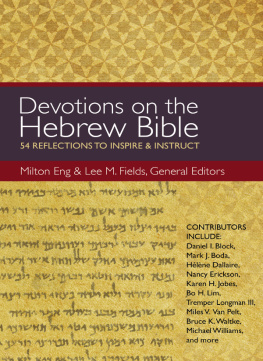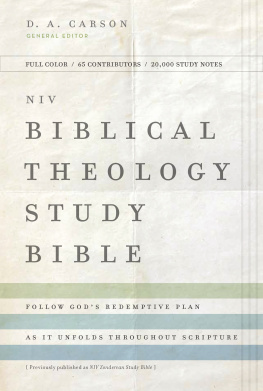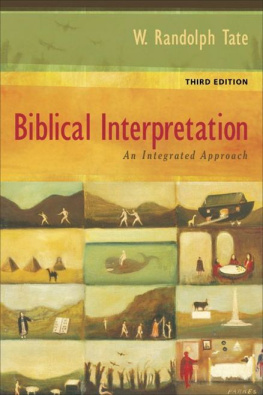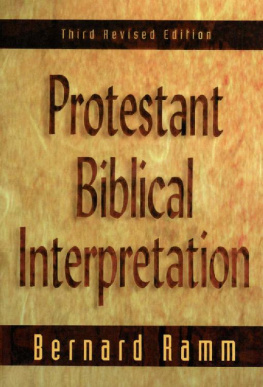To our studentspast, present, and futurewho inspire us.
Contents
Cover
Half Title Page
Title Page
Copyright Page
Dedication
Preface
Abbreviations
1. Places to Begin
Why Read the Bible?
How Did We Get the Bible?
How Shall We Read the Bible?
Suggested Reading
Part One | The Old Testament
2. Pentateuch
The Old Testament World
Primeval History
Ancestral Stories
The Composition of the Pentateuch
Exodus and Covenant
Sojourn in the Wilderness
Theological Reflection: Creation and Covenant
Suggested Reading
3. Former and Latter Prophets
Historical and Social Contexts of the Prophets
Settlement in the Land
Movement to Monarchy
The Latter Prophets
Exile and Beyond
Theological Reflection: Crises of Monarchy and Exile
Suggested Reading
The Context of the Writings
The Psalms
The Wisdom Books
Daniel
The Five Scrolls
Theological Reflection: Faith and Culture
Suggested Reading
Part Two | The New Testament
5. Between the Testaments
Sociohistorical Developments
Jewish Beliefs and Religious Practices in Antiquity
Greek and Roman Beliefs and Religious Practices in Antiquity
Suggested Reading
6. The Gospels and the Acts of the Apostles
The World of the Gospels
The Genre and Literary Tradition of the Gospels
The Gospel according to Mark
The Gospel according to Matthew
The Gospel according to Luke
The Gospel according to John
The Acts of the Apostles
Theological Reflection: Unity and Diversity
Suggested Reading
7. Paul and the Pauline Tradition
Pauls Life, Ministry, and Letters
The First Letter of Paul to the Thessalonians
The Letter of Paul to the Galatians
The First Letter of Paul to the Corinthians
The Second Letter of Paul to the Corinthians
The Letter of Paul to the Romans
The Letter of Paul to the Philippians
The Letter of Paul to Philemon
The Pauline Tradition
Theological Reflection: The Contours of Pauls Theology
Suggested Reading
The World of Early Christians
The Letter to the Hebrews
The Letter of James
The First Letter of Peter
The Second Letter of Peter and the Letter of Jude
The Johannine Letters
The Revelation to John
Theological Reflection: A Fitting Conclusion
Suggested Reading
Conclusion: Overarching Story of the Christian Scriptures
Glossary
Scripture Index
Subject Index
Back Ad
Back Cover
Preface
We intend for this volume to serve as an introductory textbook to the Christian Scriptures for students who are engaging in an informed reading of the Bible within an academic setting. Because we believe the biblical texts should function as the primary texts in such a setting, we have crafted this textbook to function as a supplemental resource. For example, we have focused our readers attention on the prevailing conversations and leading opinions within the field of biblical studies on most subjects. In other words, we have not attempted to provide exhaustive descriptions of every academic conversation about the Bible, but rather we have striven to introduce the most important conversations for students who are encountering the field of biblical studies for the first time. In the process, we have intentionally created a manageable, accessible, and affordable textbook that aims first and foremost to benefit students rather than their professors.
Methodologically, we have employed a contextual approach to the Christian Scriptures, giving attention to historical, literary, and theological contexts. Rather than telling students about the Bible, we aim to help students become educated readers of the Bible. Furthermore, while introducing critical perspectives and approaches, we have simultaneously attempted to highlight and to underscore the theological claims found within the Christian Scriptures rather than to critique or to deconstruct those claims. Consequently, our title reflects our aim. We hope beginning students will engage the Christian Scriptures. Ideally, this textbook will function as the supplemental resource that empowers students to do just that.
In this second edition of Engaging the Christian Scriptures , we have added a glossary (terms that appear there are bolded on first use in the main text), introduced some new material, updated previous material, and sought to improve the overall flow of the book. As a result, this new or updated material equates to about twenty percent of the book.
We want and need to thank many people who have helped us envision and publish this second edition of Engaging the Christian Scriptures . For starters, we are grateful to the fine people at Baker Academic. In particular, Bryan Dyer, our acquisitions editor, provided encouragement and wise counsel from the first to the last. In addition, James Korsmo, the project editor, kept us on schedule and greatly enhanced the readability and layout of this second edition. Furthermore, Sarah Gombis assembled a robust marketing strategy for the book. Thanks to all of you. Likewise, we are grateful for B. J. Parkers creative illustrations, the feedback and proofreading work that Rebecca Whitten Poe Hays, Amanda Brobst-Renaud, Kim Williams Bodenhamer, and Josiah Hall provided, and the assistance that Rebecca Whitten Poe Hays and Valerie Fisk provided in the compilation of teacher resources. We also wish to thank Baylor University for the means and resources that allowed us to tackle a project like this one, and we are grateful for the support provided by President Linda Livingstone, Provost Nancy Brickhouse, Dean Lee Nordt, Dean Todd Still, and the faculty of the Department of Religion and the George W. Truett Theological Seminary.








